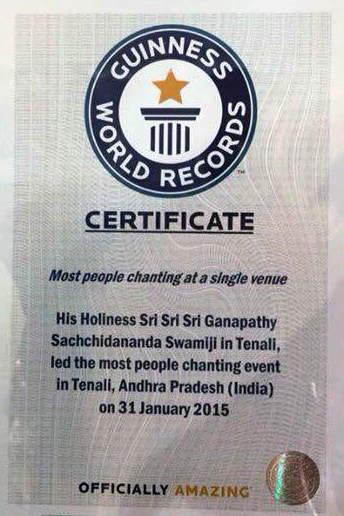It is customary to worship Lord Ganapati, at the beginning of any new task. This holds good for each and every task. Thereafter Goddess Saraswati, who is the Goddess of entire knowledge is worshipped. Thirdly, our Guru, who teaches us this knowledge and who puts us on this right path should be worshipped.
Who is a Guru? The one who takes the living entity from darkness to light is the Guru. Ignorance is the complete darkness within which the being is wholly enveloped. The Guru shows the light and takes the being on that path.
At first, prayer is offered to Ganapati, so that the obstacles on the path would be cleared, thereafter blessings are sought from the Divine Mother so that the offering would be error-free, now Guru is being prayed to so that He will lead us from darkness to light.
This ocean of repeated re-births (samsāra), together with all its bondages, is the utter darkness within which we are submerged. It is absolute ignorance. This darkness is extremely chill which means that it is dreadfully fearful. The one who shows the path out from this terribly fearful darkness is Guru.
Absolute faith in Guru is a must. Merely having darshan is inadequate. Guru should be worshipped too. The more He is worshipped, the better. We are now worshipping such a Guru.
Akhanḍa manḍalā kāraṃ vyaptam yena carācaraṃ
Tatpadaṃ darsitam yena tasmai śrī gurave namaḥ.
I offer my obeisance to that Guru, whose tattva (essence/nature of Guru) has, akin to the sky, enveloped the entire creation and which has enabled me to visualize the Brahma who is known as ‘tat’.
It is said that there can be no knowledge without a Guru. Be it any form of knowledge, a teacher (Guru) who shows the path/direction is essential. There are many who boast that they have mastered all knowledge without the help of any Guru. however one fine morning all of a sudden their knowledge will simply vanish.
One can treat the book as a Guru and learn from it. But even then, like Ekalavya, one should strive to get a direct visible Guru (pratyaksha Guru).
Even Ekalavya, who indulged in self-study, earnestly aspired and longed for a visible Guru (pratyaksha guru). Circumstances prevented Guru Drona from imparting any teaching to Ekalavya. Ekalavya returned home and made a statue of his Guru Drona. He worshipped the statue diligently. He believed that his Guru was physically present there and that he was talking and preaching to him directly.
The same logic should be applied when learning directly from book. When reading the material from the book, one should believe that there is a teacher who is teaching through the written medium. In the absence of this belief and feeling (bhavana) that what is being read is actually a lesson being taught by someone, the knowledge acquired through the reading will never be fruitful. Such knowledge will never ever be obtained completely.
That Lord Subrahmanya is a Maha Jnani (very knowledgeable) is a well-known fact. Lord Datta taught Subrahmanya the essence (tattva) of Omkaara. That’s all. Datta did not preach to him anything else except explaining the meaning behind the word ‘OM’. For this tiny teaching, Lord Subrahmanya addressed Datta as his Guru.
So it is enough if the Guru just teaches a word/alphabet or merely initiates the person into education (aksharabhyasam) or if He asks the person to undergo aksharabhyaasam. We should accept him as the Guru. It is immaterial to us whether he is a master in the subject or not. What is important to us is that he has guided us in the right direction. We should offer obeisance to Him, for being our guide.
Om Seeta raamabhyam namaha.

